Page 76 of 382
WARNING!
This vehicle is also equipped with a front passenger
air bag. Rear facing child restraints place an infant
too close to the air bag, the force of an inflating front
passenger air bag could strike a rear-facing child
restraint, causing serious or fatal injury to the child:
REAR-FACING CHILD RESTRAINTS MUST
ONLY BE USED IN THE REAR SEAT.
WARNING!
FRONT-FACING CHILD RESTRAINTS should al-
ways be used in the rear seat whenever possible; if
one must be used in the front passenger seat, adjust
the seat as far back as possible and ensure that the
child stays in the child seat properly restrained.
Failure to do so could kill or cause serious injury to
the child.
G28G3170
Air bag cover
G28G1060
76 SEATS, SEAT BELTS, CHILD RESTRAINTS AND AIR BAGS
Page 77 of 382

WARNING!
²It is important to use an approved rear facing
infant restraint until the infant is one year old to
allow the infant's neck and spine to develop
enough to support the weight of their head in the
event of a collision.
²When installing a child restraint system, follow
the instructions provided by the manufacturer
and follow the directions in this manual. Failure
to do so can result in severe or fatal injury to your
child in a collision or sudden stop.
²After installation, push and pull the child re-
straint system back and forth, and side to side, to
see that it is firmly secured. If the child restraint
system is not installed securely, it may cause
injury to the child or other occupants in the event
of a collision or sudden stop.
²When not in use, keep your child restraint system
secured with the seat belt or remove it from the
vehicle in order to prevent it from being thrown
inside the vehicle during an accident.
NOTE: Before purchasing a child restraint system, try
installing it in the rear seat to ensure a good fit. Due to the
location of the seat belt buckles and the shape of the seat
cushion it may be difficult to securely install some child
restraint systems.
If the child restraint system can be pulled forward or to
either side easily on the seat cushion after the seat belt
has been tightened, choose another child restraint sys-
tem.
²Depending on the seating position in the vehicle and
the child restraint system that you have, the child
restraint can be attached using one of the following 2
methods:
²To the lower anchorage in the rear seat ONLY if the
child restraint complies with Federal Motor Vehicle
Satety Standard 213 (See page 78).
²To the UNIBELT (See page 80).
SEATS, SEAT BELTS, CHILD RESTRAINTS AND AIR BAGS 77
3
Page 80 of 382
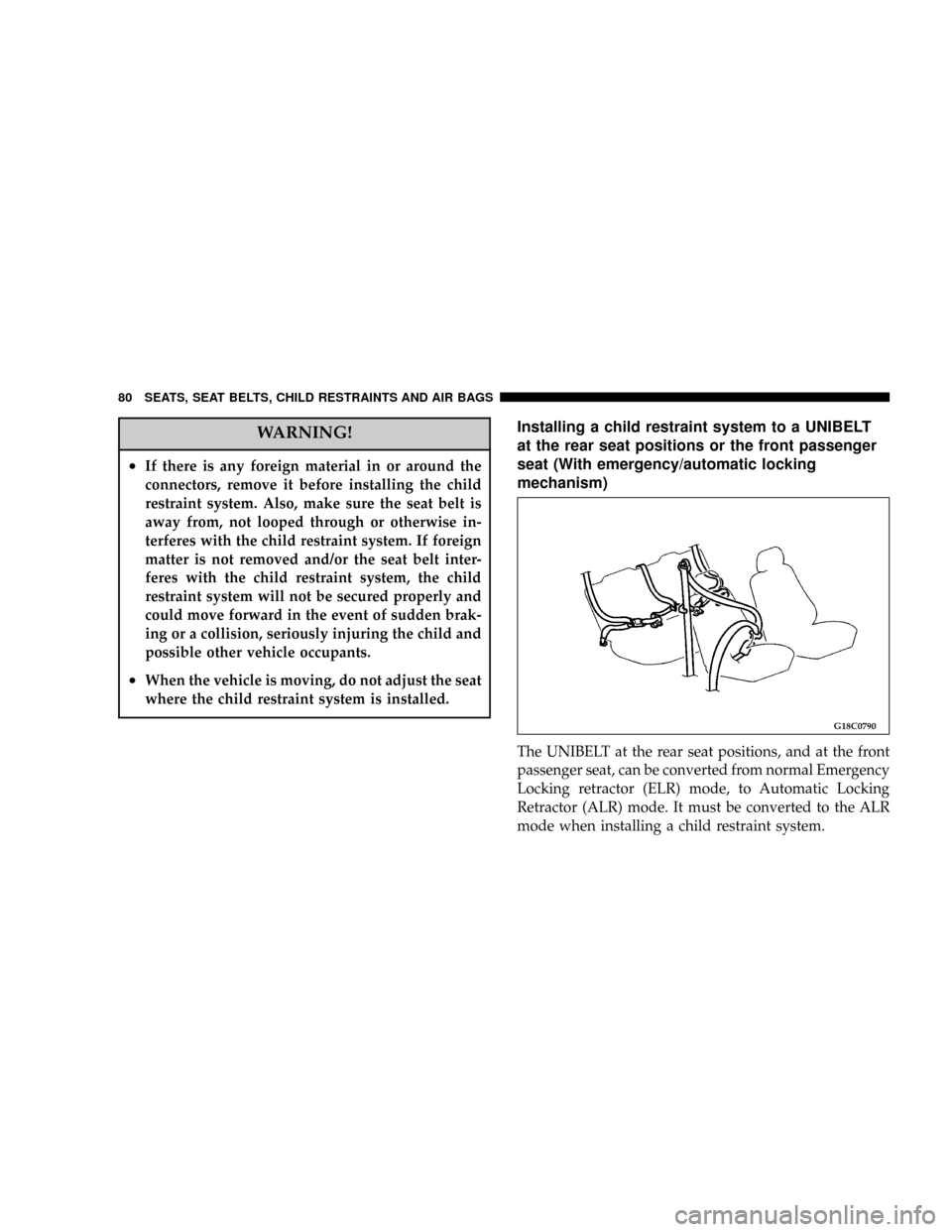
WARNING!
²If there is any foreign material in or around the
connectors, remove it before installing the child
restraint system. Also, make sure the seat belt is
away from, not looped through or otherwise in-
terferes with the child restraint system. If foreign
matter is not removed and/or the seat belt inter-
feres with the child restraint system, the child
restraint system will not be secured properly and
could move forward in the event of sudden brak-
ing or a collision, seriously injuring the child and
possible other vehicle occupants.
²When the vehicle is moving, do not adjust the seat
where the child restraint system is installed.
Installing a child restraint system to a UNIBELT
at the rear seat positions or the front passenger
seat (With emergency/automatic locking
mechanism)
The UNIBELT at the rear seat positions, and at the front
passenger seat, can be converted from normal Emergency
Locking retractor (ELR) mode, to Automatic Locking
Retractor (ALR) mode. It must be converted to the ALR
mode when installing a child restraint system.
G18C0790
80 SEATS, SEAT BELTS, CHILD RESTRAINTS AND AIR BAGS
Page 81 of 382
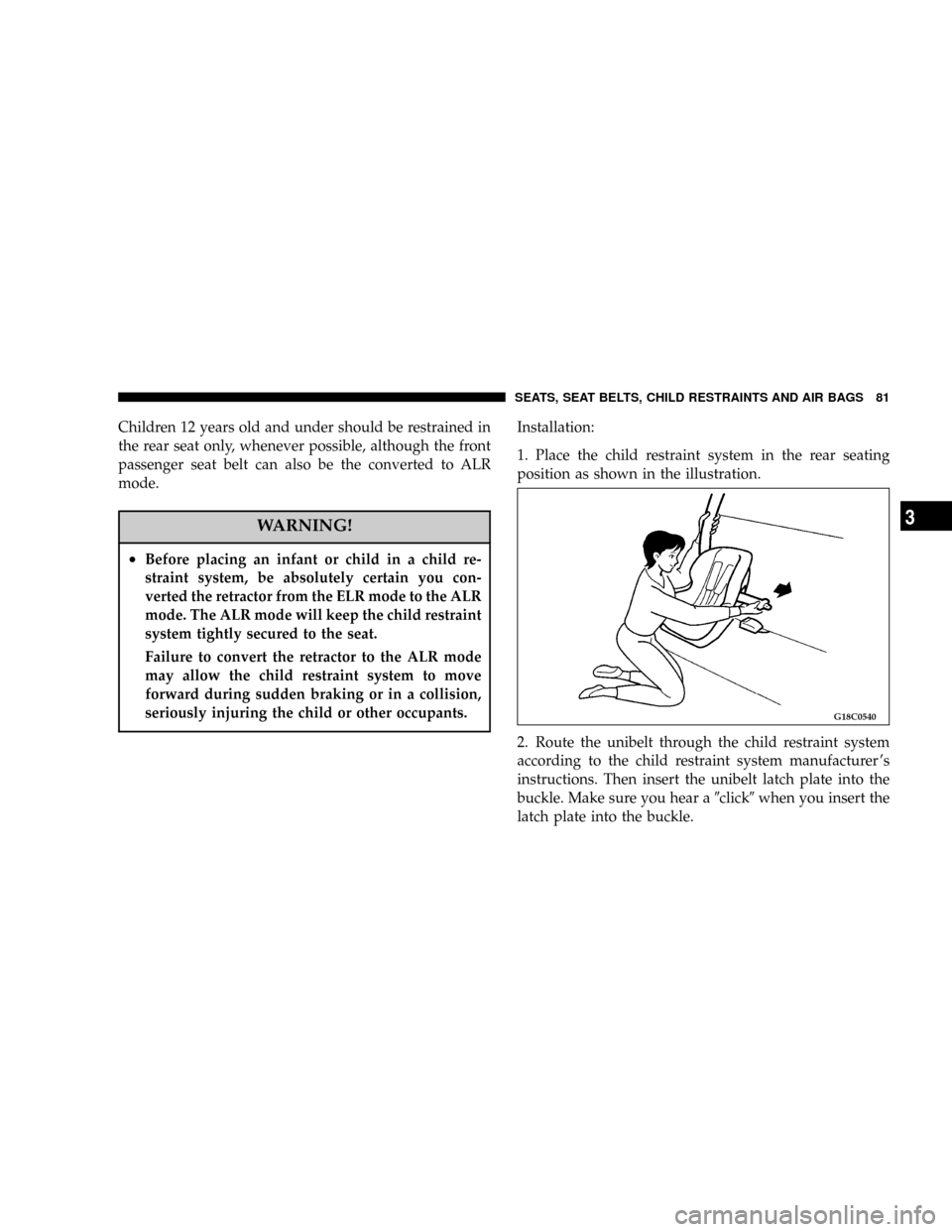
Children 12 years old and under should be restrained in
the rear seat only, whenever possible, although the front
passenger seat belt can also be the converted to ALR
mode.
WARNING!
²Before placing an infant or child in a child re-
straint system, be absolutely certain you con-
verted the retractor from the ELR mode to the ALR
mode. The ALR mode will keep the child restraint
system tightly secured to the seat.
Failure to convert the retractor to the ALR mode
may allow the child restraint system to move
forward during sudden braking or in a collision,
seriously injuring the child or other occupants.
Installation:
1. Place the child restraint system in the rear seating
position as shown in the illustration.
2. Route the unibelt through the child restraint system
according to the child restraint system manufacturer 's
instructions. Then insert the unibelt latch plate into the
buckle. Make sure you hear a9click9when you insert the
latch plate into the buckle.
G18C0540
SEATS, SEAT BELTS, CHILD RESTRAINTS AND AIR BAGS 81
3
Page 84 of 382
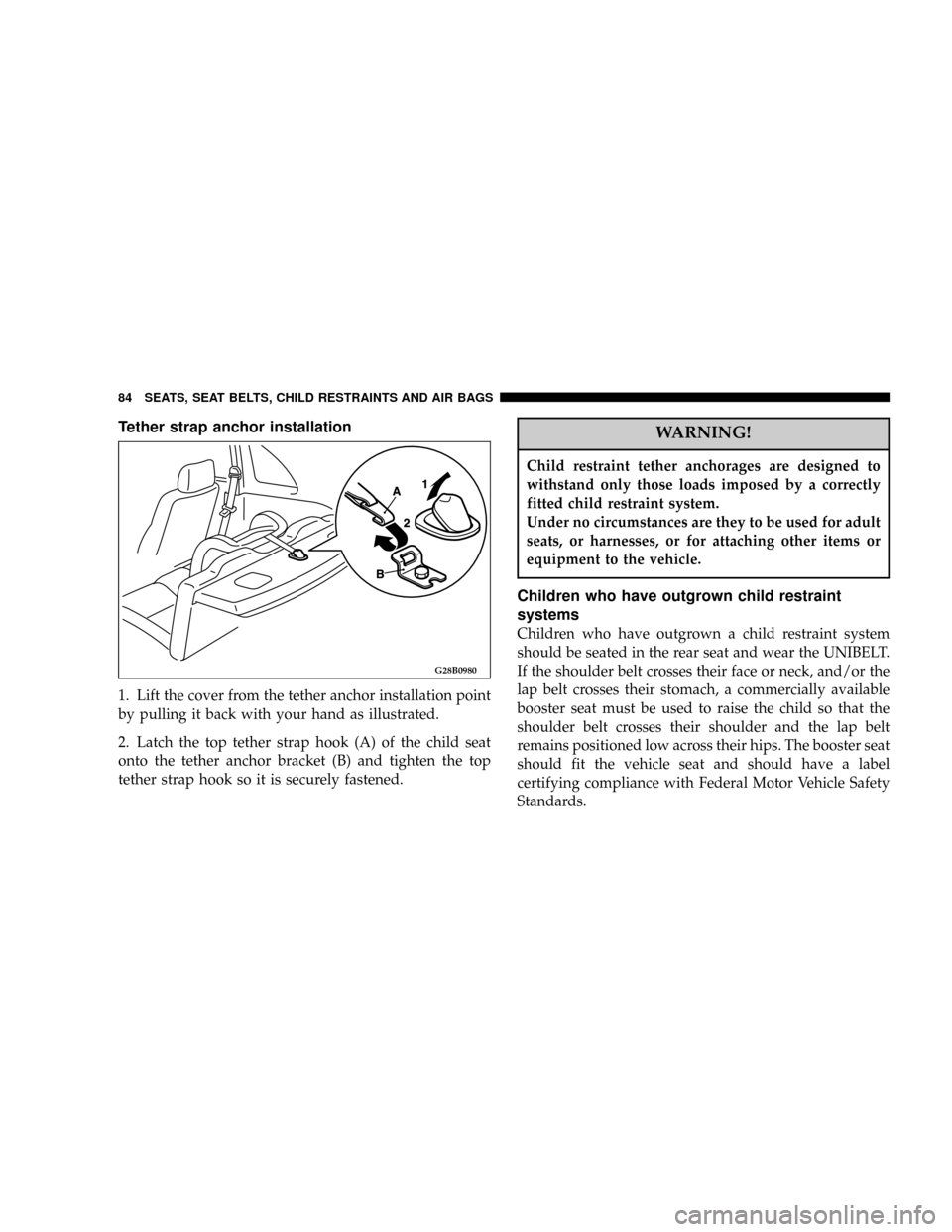
Tether strap anchor installation
1. Lift the cover from the tether anchor installation point
by pulling it back with your hand as illustrated.
2. Latch the top tether strap hook (A) of the child seat
onto the tether anchor bracket (B) and tighten the top
tether strap hook so it is securely fastened.
WARNING!
Child restraint tether anchorages are designed to
withstand only those loads imposed by a correctly
fitted child restraint system.
Under no circumstances are they to be used for adult
seats, or harnesses, or for attaching other items or
equipment to the vehicle.
Children who have outgrown child restraint
systems
Children who have outgrown a child restraint system
should be seated in the rear seat and wear the UNIBELT.
If the shoulder belt crosses their face or neck, and/or the
lap belt crosses their stomach, a commercially available
booster seat must be used to raise the child so that the
shoulder belt crosses their shoulder and the lap belt
remains positioned low across their hips. The booster seat
should fit the vehicle seat and should have a label
certifying compliance with Federal Motor Vehicle Safety
Standards.
G28B0980
84 SEATS, SEAT BELTS, CHILD RESTRAINTS AND AIR BAGS
Page 85 of 382
WARNING!
²Children who are not buckled up, with all the
doors locked, can be thrown out of the vehicle or
otherwise be seriously or fatally injured in the
event of a collision.
²A child should never be left unattended or unsu-
pervised around the vehicle. When you leave the
vehicle, always take the child out as well.
²Children can die from heat stroke if trapped
inside vehicles, especially on hot days.
²Keep vehicles locked and trunks closed when not
in use. Keep vehicle keys away from children.
Seat Belts And Pregnant Women
We recommend that pregnant women use the seat belts
throughout their pregnancy. Keeping the mother safe is
the best way to keep the baby safe.
Pregnant women should wear the lap part of the belt
across the thighs and as snug across the hips as possible.
Keep the belt low so that it does not come across the
abdomen. That way the strong bones of the hips will take
the force if there is a collision.
SEATS, SEAT BELTS, CHILD RESTRAINTS AND AIR BAGS 85
3
Page 87 of 382
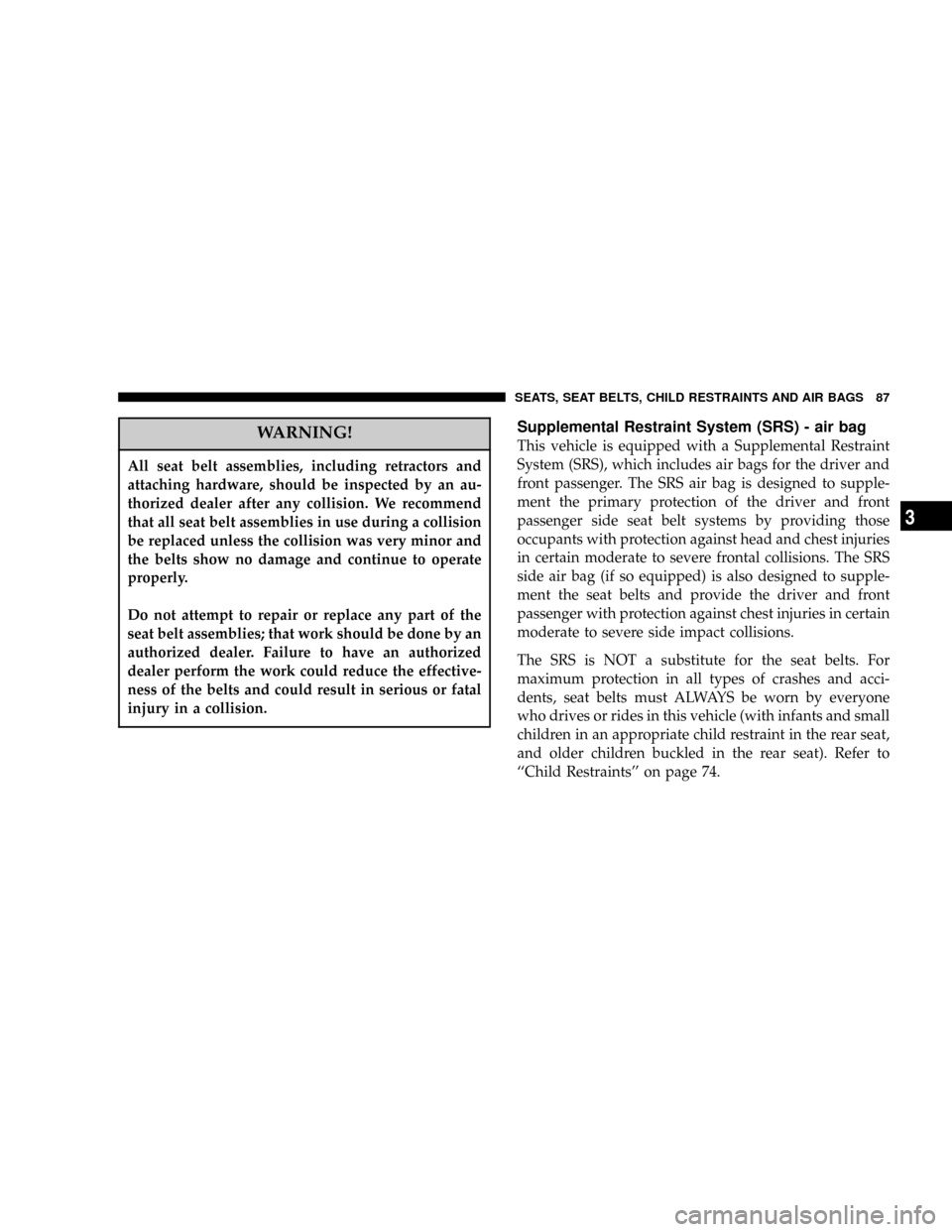
WARNING!
All seat belt assemblies, including retractors and
attaching hardware, should be inspected by an au-
thorized dealer after any collision. We recommend
that all seat belt assemblies in use during a collision
be replaced unless the collision was very minor and
the belts show no damage and continue to operate
properly.
Do not attempt to repair or replace any part of the
seat belt assemblies; that work should be done by an
authorized dealer. Failure to have an authorized
dealer perform the work could reduce the effective-
ness of the belts and could result in serious or fatal
injury in a collision.
Supplemental Restraint System (SRS) - air bag
This vehicle is equipped with a Supplemental Restraint
System (SRS), which includes air bags for the driver and
front passenger. The SRS air bag is designed to supple-
ment the primary protection of the driver and front
passenger side seat belt systems by providing those
occupants with protection against head and chest injuries
in certain moderate to severe frontal collisions. The SRS
side air bag (if so equipped) is also designed to supple-
ment the seat belts and provide the driver and front
passenger with protection against chest injuries in certain
moderate to severe side impact collisions.
The SRS is NOT a substitute for the seat belts. For
maximum protection in all types of crashes and acci-
dents, seat belts must ALWAYS be worn by everyone
who drives or rides in this vehicle (with infants and small
children in an appropriate child restraint in the rear seat,
and older children buckled in the rear seat). Refer to
``Child Restraints'' on page 74.
SEATS, SEAT BELTS, CHILD RESTRAINTS AND AIR BAGS 87
3
Page 88 of 382
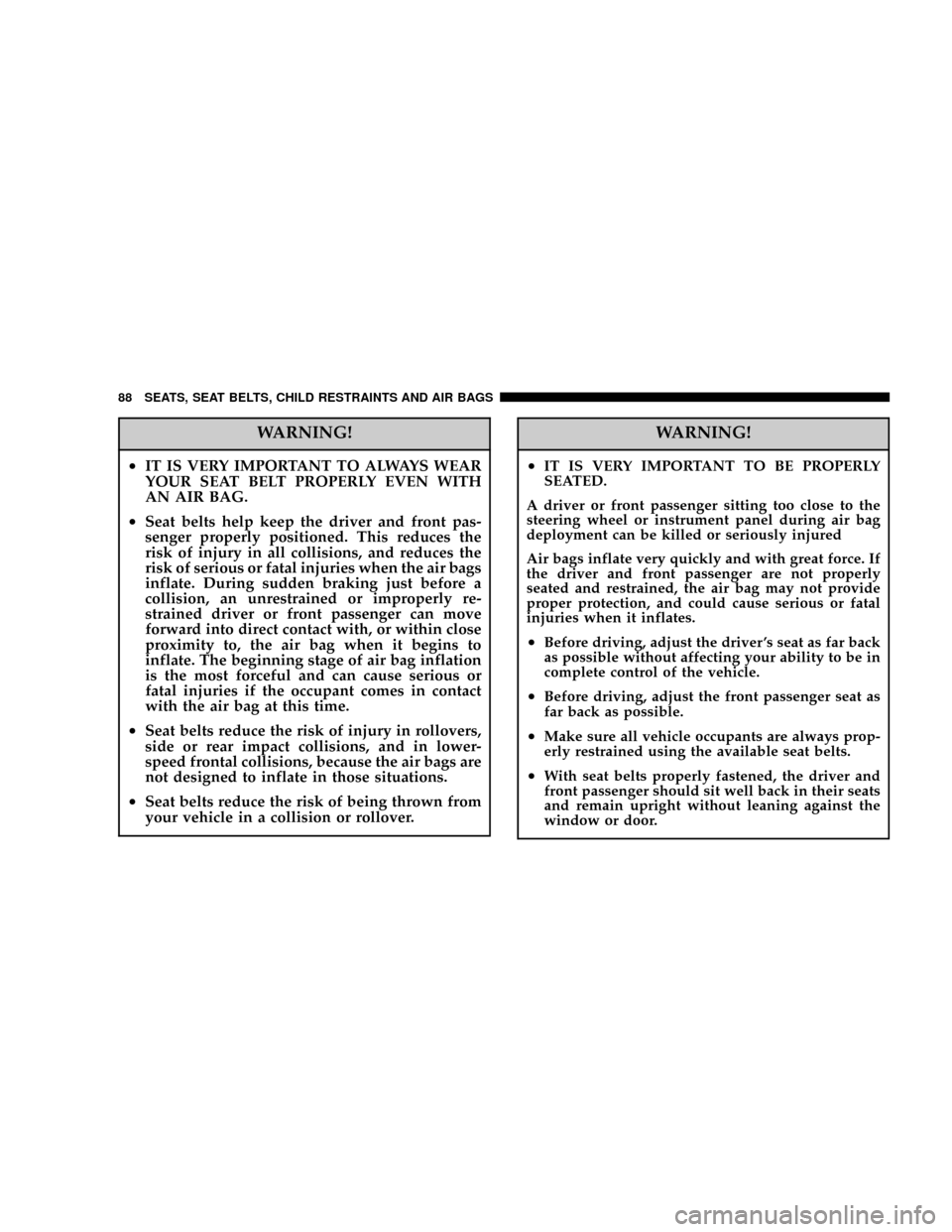
WARNING!
²IT IS VERY IMPORTANT TO ALWAYS WEAR
YOUR SEAT BELT PROPERLY EVEN WITH
AN AIR BAG.
²Seat belts help keep the driver and front pas-
senger properly positioned. This reduces the
risk of injury in all collisions, and reduces the
risk of serious or fatal injuries when the air bags
inflate. During sudden braking just before a
collision, an unrestrained or improperly re-
strained driver or front passenger can move
forward into direct contact with, or within close
proximity to, the air bag when it begins to
inflate. The beginning stage of air bag inflation
is the most forceful and can cause serious or
fatal injuries if the occupant comes in contact
with the air bag at this time.
²Seat belts reduce the risk of injury in rollovers,
side or rear impact collisions, and in lower-
speed frontal collisions, because the air bags are
not designed to inflate in those situations.
²Seat belts reduce the risk of being thrown from
your vehicle in a collision or rollover.
WARNING!
²IT IS VERY IMPORTANT TO BE PROPERLY
SEATED.
A driver or front passenger sitting too close to the
steering wheel or instrument panel during air bag
deployment can be killed or seriously injured
Air bags inflate very quickly and with great force. If
the driver and front passenger are not properly
seated and restrained, the air bag may not provide
proper protection, and could cause serious or fatal
injuries when it inflates.
²Before driving, adjust the driver 's seat as far back
as possible without affecting your ability to be in
complete control of the vehicle.
²Before driving, adjust the front passenger seat as
far back as possible.
²Make sure all vehicle occupants are always prop-
erly restrained using the available seat belts.
²With seat belts properly fastened, the driver and
front passenger should sit well back in their seats
and remain upright without leaning against the
window or door.
88 SEATS, SEAT BELTS, CHILD RESTRAINTS AND AIR BAGS